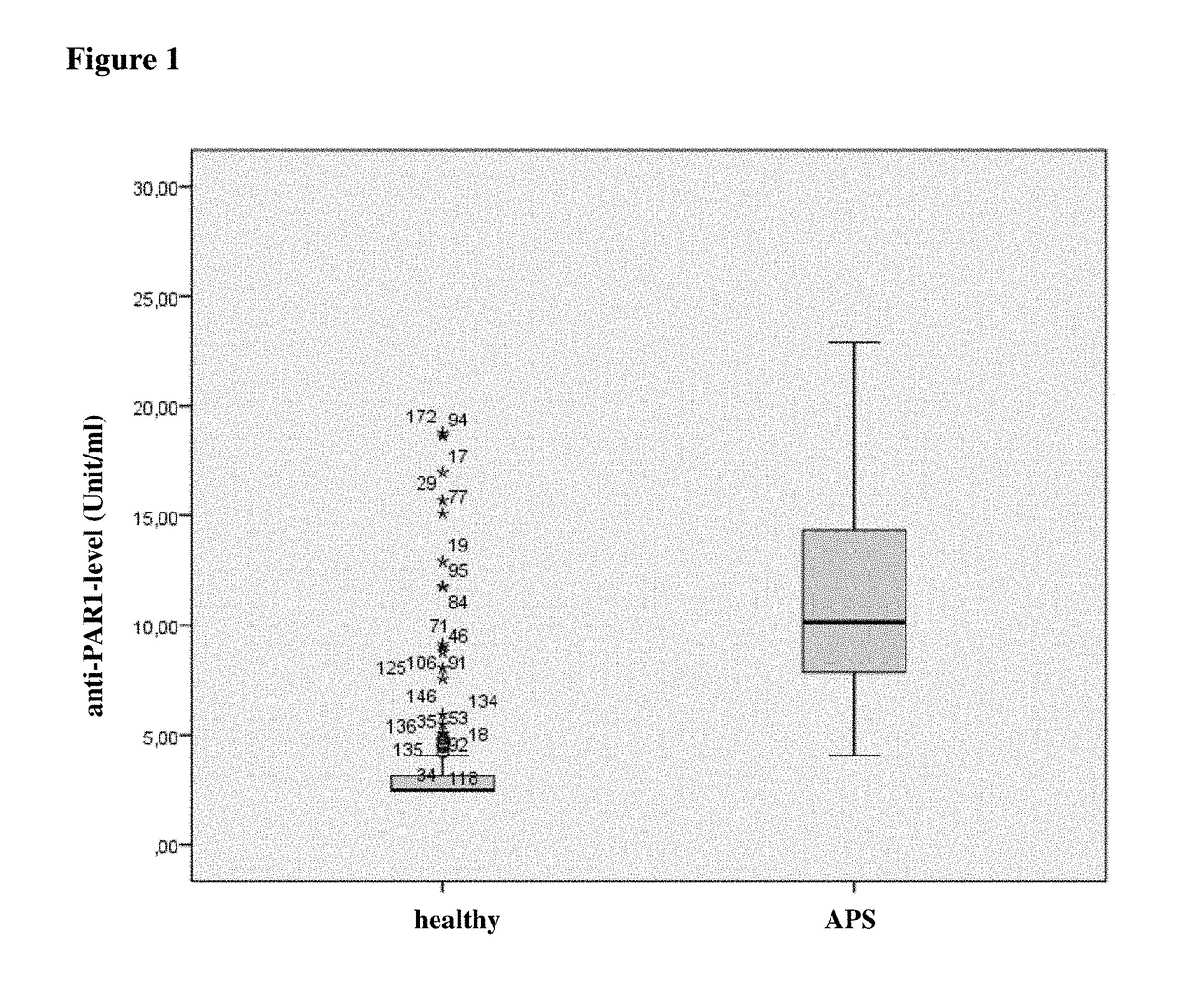Method for diagnosing APS using determination of anti-PAR1 antibodies
a technology of anti-par1 antibodies and aps, applied in the field of medicine, can solve the problems of high risk of death, laborious and time-consuming diagnosis, and rapid organ failur
- Summary
- Abstract
- Description
- Claims
- Application Information
AI Technical Summary
Benefits of technology
Problems solved by technology
Method used
Image
Examples
example 1
[0083]We measured the anti-PAR1 autoantibody in serum samples using a sandwich ELISA kit (CellTrend GmbH Luckenwalde, Germany). The microtiter 96-well polystyrene plates were coated with chemically synthesized human PAR1 isoform 1 (SEQ ID NO:1). To maintain the conformational epitopes of the receptor, 1 mM calcium chloride was added to every buffer. Duplicate samples of a 1:100 serum dilution were incubated at 4° C. for 2 hours. After washing steps, plates were incubated for 60 minutes with a 1:20.000 dilution of horseradish-peroxidase-labeled goat anti-human IgG (Jackson, USA) used for detection. In order to obtain a standard curve, plates were incubated with test sera from an anti-PAR1 autoantibody positive index patient. The ELISA was validated according to the FDA's “Guidance for industry: Bioanalytical method validation”.
[0084]To set a standard for the concentrations of the autoimmune antibodies, a standard curve was generated. In detail, a serum sample of a systemic sclerosis ...
example 2
[0085]Anti-PAR1 antibody levels in serum samples from 198 healthy donors (“healthy”) and 83 patients with APS (“APS”) were measured using the kit and method of example 1. The levels were determined in units / mL. FIG. 1 shows the comparison of anti-PAR1 antibody level for case and control subjects. Patient suffering from APS had significantly increased levels (p<0.05) of anti-PAR1 antibodies as compared to healthy controls.
[0086]The analysis of percentiles revealed the following results:
TABLE 1Percentiles (weighted mean): Anti-PAR1-antibody levels-percentile in healthy donors (n = 198) and subjectssuffering from APS (n = 83).Percentile5102550759095healty subjects3.144.829.27(units / ml)Subjects with APS4.405.157.8210.1514.5020.2721.89(units / ml)
[0087]These data show that a threshold of e.g. 4 unit / ml lies within the 5th percentile of subjects with APS and about 90th of healthy subject, i.e. 95 percent of patients with APS have a higher level than 4 units / ml and 90 percent of healthy subj...
PUM
| Property | Measurement | Unit |
|---|---|---|
| optical density | aaaaa | aaaaa |
| threshold | aaaaa | aaaaa |
| fluorescence immunoassay | aaaaa | aaaaa |
Abstract
Description
Claims
Application Information
 Login to View More
Login to View More - Generate Ideas
- Intellectual Property
- Life Sciences
- Materials
- Tech Scout
- Unparalleled Data Quality
- Higher Quality Content
- 60% Fewer Hallucinations
Browse by: Latest US Patents, China's latest patents, Technical Efficacy Thesaurus, Application Domain, Technology Topic, Popular Technical Reports.
© 2025 PatSnap. All rights reserved.Legal|Privacy policy|Modern Slavery Act Transparency Statement|Sitemap|About US| Contact US: help@patsnap.com



